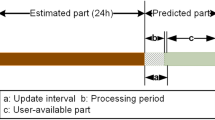Abstract
The precise point positioning (PPP) is a popular positioning technique that is dependent on the use of precise orbits and clock corrections. One serious problem for real-time PPP applications such as natural hazard early warning systems and hydrographic surveying is when a sudden communication break takes place resulting in a discontinuity in receiving these orbit and clock corrections for a period that may extend from a few minutes to hours. A method is presented to maintain real-time PPP with 3D accuracy less than a decimeter when such a break takes place. We focus on the open-access International GNSS Service (IGS) real-time service (RTS) products and propose predicting the precise orbit and clock corrections as time series. For a short corrections outage of a few minutes, we predict the IGS-RTS orbits using a high-order polynomial, and for longer outages up to 3 h, the most recent IGS ultra-rapid orbits are used. The IGS-RTS clock corrections are predicted using a second-order polynomial and sinusoidal terms. The model parameters are estimated sequentially using a sliding time window such that they are available when needed. The prediction model of the clock correction is built based on the analysis of their properties, including their temporal behavior and stability. Evaluation of the proposed method in static and kinematic testing shows that positioning precision of less than 10 cm can be maintained for up to 2 h after the break. When PPP re-initialization is needed during the break, the solution convergence time increases; however, positioning precision remains less than a decimeter after convergence.









Similar content being viewed by others
References
Allan D (1987) Time and frequency (time-domain) characterization, estimation and prediction of precision clocks and oscillators. IEEE Trans Ultrason Ferroelectr Freq Control 34:647–654
Box G, Jenkins G, Reinsel G (1994) Time series analysis: forecasting and control, 3rd edn. Prentice-Hall, Upper Saddle River
Chatfield C, Yar M (1991) Prediction intervals for multiplicative holt-winters. Int J Forecast 7:31–37
El-Mowafy A (2006) On-the-fly prediction of orbit corrections for RTK positioning. J Navig 59(2):321–334
El-Mowafy A (2014) GNSS multi-frequency receiver single-satellite measurement validation method. GPS Solut 18(4):553–561
El-Mowafy A (2015) Estimation of multi-constellation GNSS observation stochastic properties using a single-receiver single-satellite data validation method. Surv Rev 47–341:99–108
Ferre-Pikal ES et al. (1997) Draft revision of IEEE STD 1139-1988 standard definitions of physical quantities for fundamental frequency and time metrology-random instabilities. IEEE International Frequency Control Symposium, Orlando 338–357
Hackman C (2012) Accuracy/precision of USNO predicted clock estimates for GPS satellites. 44th Annual PTTI Systems and Applications Meeting, Reston 43–52
Hadas T, Bosy J (2015) IGS RTS precise orbits and clocks verification and quality degradation over time. GPS Solut 19(1):93–105
Heo JH, Cho J, Heo MB (2010) Improving prediction accuracy of GPS satellite clocks with periodic variation behavior. Meas Sci Technol 21:1–8
Huang GW, Zhang Q, Xu GC (2014) Real-time clock offset prediction with an improved model. GPS Solut 18(1):95–104
Jin SG, Komjathy A (2010) GNSS reflectometry and remote sensing: new objectives and results. Adv Space Res 46(2):111–117
Kruskal WH, Wallis A (1952) Use of ranks in one-criterion variance analysis. J Am Stat Assoc 47(260):583–621
Montenbruck O, Gill E (2000) Satellite orbits: models, methods, and applications. Springer, Berlin Heidelberg
Leandro R et al. (2011) RTX positioning: the next generation of cm-accurate real-time GNSS positioning. In: Proc ION GNSS 2011, Institute of Navigation, Portland 1460–1475
Seppänen M et al (2012) Autonomous prediction of GPS and GLONASS satellite orbits. Navigation 59(2):119–134
Snyder JJ (1981) An ultra-high resolution frequency meter. In: Proceedings of 35th Ann, Freq. Control Symposium, Ft. Monmouth, NJ, 07703: 464–469
Trigo L, Slomovitz D (2011) Long term experimental results of a rubidium atomic clock with drift compensation. In: Proc SEMETRO 10, Natal, Brasil 1–3
Acknowledgements
The Institute for Geoscience Research (TIGeR), Curtin University, is acknowledged for partially funding this research.
Author information
Authors and Affiliations
Corresponding author
Rights and permissions
About this article
Cite this article
El-Mowafy, A., Deo, M. & Kubo, N. Maintaining real-time precise point positioning during outages of orbit and clock corrections. GPS Solut 21, 937–947 (2017). https://doi.org/10.1007/s10291-016-0583-4
Received:
Accepted:
Published:
Issue Date:
DOI: https://doi.org/10.1007/s10291-016-0583-4




